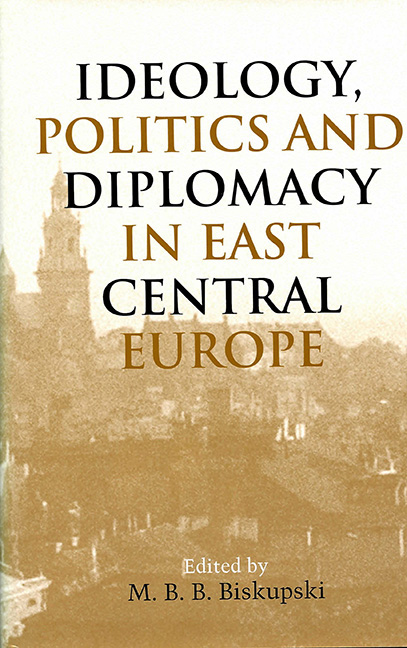Book contents
- Frontmatter
- Contents
- Preface
- Tabula Honoraria
- Piotr Wandycz
- Piotr Wandycz: An Appreciation
- 1 A Comparison of Czech Politics in Bohemia with Czech Politics in Moravia, 1860–1914
- 2 Strategy, Politics, and Suffering: The Wartime Relief of Belgium, Serbia, and Poland, 1914–1918
- 3 “This Troublesome Question”: The United States and the “Polish Pogroms” of 1918–1919
- 4 The Socialist Imprint on International Relations in Interwar Europe
- 5 Hungarian Americans during World War II: Their Role in Defending Hungary's Interests
- 6 The Nazi-Soviet Pact of August 23, 1939: When Did Stalin Decide to Align with Hitler, and Was Poland the Culprit?
- 7 Poland, the GDR, and the “Ulbricht Doctrine”
- Writings of Piotr S. Wandycz
- Contributors
- Index
4 - The Socialist Imprint on International Relations in Interwar Europe
Published online by Cambridge University Press: 11 May 2017
- Frontmatter
- Contents
- Preface
- Tabula Honoraria
- Piotr Wandycz
- Piotr Wandycz: An Appreciation
- 1 A Comparison of Czech Politics in Bohemia with Czech Politics in Moravia, 1860–1914
- 2 Strategy, Politics, and Suffering: The Wartime Relief of Belgium, Serbia, and Poland, 1914–1918
- 3 “This Troublesome Question”: The United States and the “Polish Pogroms” of 1918–1919
- 4 The Socialist Imprint on International Relations in Interwar Europe
- 5 Hungarian Americans during World War II: Their Role in Defending Hungary's Interests
- 6 The Nazi-Soviet Pact of August 23, 1939: When Did Stalin Decide to Align with Hitler, and Was Poland the Culprit?
- 7 Poland, the GDR, and the “Ulbricht Doctrine”
- Writings of Piotr S. Wandycz
- Contributors
- Index
Summary
In the middle of October 1925, the world's attention abruptly turned to the town of Locarno, a small resort off the beaten track in southeastern Switzerland. The foreign ministers of the major states of Europe had selected this unlikely spot to finalize an agreement on Germany's borders. The fact that it took place in an obscure venue with limited hotel space and inadequate telephone connections did not prevent the Locarno conference, and the pact it produced, from becoming the media sensation of the year in international affairs. Overnight, a glamorous political counterpart was born to the notably less-hyped Dawes Plan of the previous April.
This American initiative had stabilized the Weimar Republic, Germany's first experiment in full-blown parliamentarianism, by opening the spigot on short-term loans to the ailing German economy. The connection between Dawes and Locarno was an obvious one. Not unlike the Marshall Plan twenty-three years later, Wall Street's decision to take its investments where the Senate had earlier refused to extend political guarantees provided much-needed liquidity. In part, Dawes was a way to dispose of excess capital, but the more profound motive was the American financial community's concern about the link between German reparations, French payments on British loans, and British debts in the United States. Again, similar to the Marshall Plan's requirement that American aid be centrally distributed, the Dawes Plan required an intra-European agreement to regulate and restructure the reparations payments that had been imposed upon Germany at Versailles. With Dawes having thus laid the economic base, Locarno constituted the next, more expansive step in Germany's reintegration into the international system. Whereas Dawes has been posited on the notion that German economic well-being was indispensable, Locarno was rooted in the belief that long-term stability in Western Europe could and should be purchased at the price of recognizing Germany's right to redress the allegedly unjust territorial losses it had suffered in the east and at the end of the war. Driving this one-two combination in what socialists liked to call Europe's “pacification” was a new type of international political economy. Before 1918, it would have been unthinkable that German domestic stability could depend directly on the American bond markets.
- Type
- Chapter
- Information
- Ideology, Politics, and Diplomacy in East Central Europe , pp. 80 - 119Publisher: Boydell & BrewerPrint publication year: 2003

